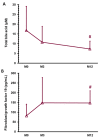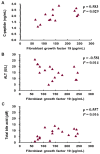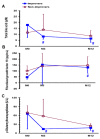Bile Acid and Fibroblast Growth Factor 19 Regulation in Obese Diabetics, and Non-Alcoholic Fatty Liver Disease after Sleeve Gastrectomy
- PMID: 31181641
- PMCID: PMC6616896
- DOI: 10.3390/jcm8060815
Bile Acid and Fibroblast Growth Factor 19 Regulation in Obese Diabetics, and Non-Alcoholic Fatty Liver Disease after Sleeve Gastrectomy
Abstract
Background: Sleeve gastrectomy (SG) is an effective treatment for obesity and type 2 diabetes mellitus (T2DM), and non-alcoholic fatty liver disease (NAFLD); however, the mechanism is not completely understood. Bile acids and fibroblast growth factors (FGFs) are involved in the regulation of energy metabolism.
Methods: We investigated the roles of total bile acid and FGF 19 in T2DM remission and NAFLD improvement in obese subjects undergoing SG. A total of 18 patients with obesity and T2DM undergoing laparoscopic SG were enrolled in this study. Serial plasma total bile acid and FGF 19 levels were measured, while the fatty liver index was calculated before and after surgery.
Results: The FGF 19 level significantly increased, and the total bile acid level and fatty liver index decreased 1 year after surgery. The complete T2DM remission rate was 66.7% one year after surgery; the complete remitters had significantly lower FGF 19 levels and higher insulin levels than the non-complete remitters. The complete remitters also had significantly decreased total bile acid levels and increased FGF 19 levels 1 year after surgery compared with those before surgery. The fatty improvers had significantly decreased total bile acid levels and increased FGF 19 levels 1 year after surgery compared with those before surgery.
Conclusion: The total bile acids level and fatty liver index decreased, and the FGF 19 levels increased 1 year after SG. Both T2DM complete remitters and NAFLD improvers showed significantly decreased total bile acid levels and increased FGF 19 levels 1 year after SG. Plasma total bile acids and FGF 19 might have roles in T2DM remission and NAFLD improvement. Low preoperative FGF 19 levels might be a predictor for NAFLD improvement after SG.
Keywords: FGF 19; diabetes mellitus; non-alcoholic fatty liver disease; sleeve gastrectomy; total bile acid.
Conflict of interest statement
The authors report no conflicts of interest in this work.
Figures




Similar articles
-
Fibroblast Growth Factor 19 and Fibroblast Growth Factor 21 Regulation in Obese Diabetics, and Non-Alcoholic Fatty Liver Disease after Gastric Bypass.Nutrients. 2022 Feb 2;14(3):645. doi: 10.3390/nu14030645. Nutrients. 2022. PMID: 35277004 Free PMC article.
-
Effects of Sleeve Gastrectomy on Nonalcoholic Fatty Liver Disease in an Obese Rat Model.Obes Surg. 2018 Jun;28(6):1532-1539. doi: 10.1007/s11695-017-3052-4. Obes Surg. 2018. PMID: 29280057
-
Combined Non-alcoholic Fatty Liver Disease and Type 2 Diabetes Mellitus: Sleeve Gastrectomy or Gastric Bypass?-a Controlled Matched Pair Study of 34 Patients.Obes Surg. 2016 Aug;26(8):1867-74. doi: 10.1007/s11695-015-2006-y. Obes Surg. 2016. PMID: 26660688
-
Insulin secretion and interleukin-1β dependent mechanisms in human diabetes remission after metabolic surgery.Curr Med Chem. 2013;20(18):2374-88. doi: 10.2174/0929867311320180008. Curr Med Chem. 2013. PMID: 23531221
-
Changes in Bile Acid Metabolism, Transport, and Signaling as Central Drivers for Metabolic Improvements After Bariatric Surgery.Curr Obes Rep. 2019 Jun;8(2):175-184. doi: 10.1007/s13679-019-00334-4. Curr Obes Rep. 2019. PMID: 30847736 Review.
Cited by
-
Role of diet and lifestyle modification in the management of nonalcoholic fatty liver disease and type 2 diabetes.Tzu Chi Med J. 2020 Oct 5;33(2):135-145. doi: 10.4103/tcmj.tcmj_86_20. eCollection 2021 Apr-Jun. Tzu Chi Med J. 2020. PMID: 33912410 Free PMC article. Review.
-
Risk of anemia in morbidly obese patients after bariatric surgery in Taiwan.World J Diabetes. 2020 Oct 15;11(10):447-458. doi: 10.4239/wjd.v11.i10.447. World J Diabetes. 2020. PMID: 33133392 Free PMC article.
-
Gut Microbiota Dysbiosis and Its Impact on Type 2 Diabetes: From Pathogenesis to Therapeutic Strategies.Metabolites. 2025 Jun 12;15(6):397. doi: 10.3390/metabo15060397. Metabolites. 2025. PMID: 40559421 Free PMC article. Review.
-
Interactive Relationships between Intestinal Flora and Bile Acids.Int J Mol Sci. 2022 Jul 28;23(15):8343. doi: 10.3390/ijms23158343. Int J Mol Sci. 2022. PMID: 35955473 Free PMC article. Review.
-
State of art on the mechanisms of laparoscopic sleeve gastrectomy in treating type 2 diabetes mellitus.World J Diabetes. 2023 Jun 15;14(6):632-655. doi: 10.4239/wjd.v14.i6.632. World J Diabetes. 2023. PMID: 37383590 Free PMC article. Review.
References
-
- Düfer M., Hörth K., Wagner R., Schittenhelm B., Prowald S., Wagner T.F., Oberwinkler J., Lukowski R., Gonzalez F.J., Krippeit-Drews P., et al. Bile acids acutely stimulate insulin secretion of mouse β-cells via farnesoid X receptor activation and K(ATP) channel inhibition. Diabetes. 2012;61:1479–1489. doi: 10.2337/db11-0815. - DOI - PMC - PubMed
-
- Shaham O., Wei R., Wang T.J., Ricciardi C., Lewis G.D., Vasan R.S., Carr S.A., Thadhani R., Gerszten R.E., Mootha V.K. Metabolic profiling of the human response to a glucose challenge reveals distinct axes of insulin sensitivity. Mol. Syst. Biol. 2008;4:214. doi: 10.1038/msb.2008.50. - DOI - PMC - PubMed
Grants and funding
LinkOut - more resources
Full Text Sources

